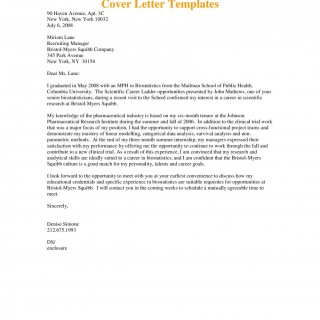Cover letter
Cover letter is a letter of introduction attached to document such as a resume or curriculum vitae. A cover letter typically accompanies each resume you send out. Your cover letter may make the difference between obtaining a job interview and having your resume ignored, so, it makes good sense to devote the necessary time and effort to writing effective cover letters.
Cover letter and resume usually provide all the information which a prospective employer will use to decide whether or not you will reach the next phase in the application process: the interview. While your goal is an interview and, ultimately, a job offer, the more immediate purpose of your cover letter in some cases may simply be to gain an attentive audience for your resume.
There are three types of cover letters:
- the application letter which responds to a known job opening
- the prospecting letter which inquires about possible positions
- the networking letter which requests information and assistance in your job search
Your cover letter should be designed specifically for each purpose outlined above as well as for each position you seek. Do not design a form letter and send it to every potential employer.
Effective cover letters explain the reasons for your interest in the specific organization and identify your most relevant skills or experiences (remember, relevance is determined by the employer's self-interest). They should express a high level of interest and knowledge about the position.
Cover Letters Format
Header. Cover letters use standard business letter style, with the sender's address and other information, the recipient's contact information, and the date sent after either the sender's or the recipient's address. Following that is an optional reference section and an optional transmission note. The final part of the header is a salutation.
Introduction. The introduction briefly states the specific position desired, and is designed to catch the employer's immediate interest.
Body. The body highlights or amplifies on material in the resume or job application, and explains why the job seeker is interested in the job and would be of value to the employer. Also, matters discussed typically include skills, qualifications, and past experience. If there are any special things to note such as availability date, they may be included as well.
The body of your letter should consist of one to three longer paragraphs in which you expand upon your qualifications for the position. Pick out the most relevant qualifications listed in your resume and discuss them in detail, demonstrating how your background and experience qualify you for the job. Be as specific as possible, and refer the reader to your resume for additional details.
Closing. A closing sums up the letter, and indicates the next step the applicant expects to take. It may indicate that the applicant intends to contact the employer, although many favor the more indirect approach of simply saying that the applicant will look forward to hearing from or speaking with the employer. The concluding paragraph of your letter should request an interview. State where and when you can be reached, and express your willingness to come to an interview or supply further information. Close by thanking your reader for his or her time and consideration.

